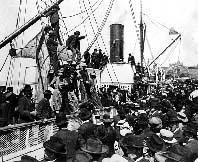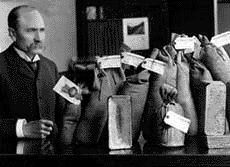By Sharon Boswell
and Lorraine McConaghy
Special to the Times 
Crowds jammed Seattle's docks, headed for the gold fields of the Yukon
River and its tributaries -- the region of Alaska and Canada known to adventurers
and residents alike as the Klondike. Backed by local newspapers and the Chamber of
Commerce, Seattle became the West Coast portal to the Klondike. Photo Credit: Seattle Times.
IN 1896,"DOWNTOWN
SEATTLE" WAS JUST A FEW BLOCKS OF DENSE URBAN CONSTRUCTION between First and Third avenues, on either side of Yesler
Way. Respectable commerce moved north up the avenues away from the heart of the city in Pioneer Place, now known as
Pioneer Square. Saloons, gambling dens and brothels stretched to the south.
When newcomer Alden J.
Blethen bought his first stake in The Seattle Times that year, Seattle was raw and broke a frontier seaport on the
long downside of a boom-and-bust economy.
Recent completion of the Great Northern Railways
transcontinental track to the city revived hopes that Seattle might become the commercial hub for a great hinterland of
timber, wheat and coal. But the town still suffered the after-effects of 1893s national panic, when distant investors
withdrew their funds from local projects. Seattle couldn't meet its own payrolls, and a stream of jobless men abandoned
the city in search of better prospects.
Overnight, everything changed. On July 17, 1897, the
steamer Portland docked in Seattles harbor carrying 70 ordinary men who had brought back a million dollars in gold
from the streams of the Yukon River. Their fantastic stories coursed through the city streets.
It was
a half a ton of gold -- no, a ton!-- and the nuggets lay big as marbles, bright in the streambeds, just there for the
taking. As The Times quoted a wide-eyed prospector, "This is the richest thing ever known. Everybody is crazy." The
bonanza promised wealth to anyone who could get to the Klondike, and the great rush was on.
Seattles newspapers hurried into print, typesetting the various spellings of Clondyke, Klondyke and
Klondike in the first few weeks of the Gold Rush. Readers turned to the dailies for news, maps of the route and the
diggings, advice on when to go and what to bring, and advertisements from steamship companies and local outfitters.

Andrew Chilberg, left, president of Seattle's Scandinavian-American Bank, shows off deposits of Yukon gold dust and bars in 1900. Photo Credit: Seattle Times.
VETERAN SEATTLE JOURNALIST JOSEPH COSTELLO TREKKED NORTHWARD to the Klondike to make his fortune,
and mailed his first-person dispatches back to The Times, warning readers about treacherous snowstorms and Dawson City
scams. The newspapers published guides to the Yukon, and the citys new Klondike Information Bureau distributed
thousands of copies throughout the United States.
In that first summer, 10,000 Seattle men and
boys left town for the Alaskan and Canadian gold fields; even the mayor resigned to try his luck. But the citys
population doubled during the next four years as the Klondikes golden wave washed boomtown prosperity over
Seattle.
Local entrepreneurs manufactured prospectors necessities like woolen blankets, dried
eggs and collapsible boats; shopkeepers offered complete Yukon outfits of provisions and camping equipment; steamship
companies doubled their fleets and shipyards rushed to meet the demand.
And Gold Rush Seattle
became notorious for wide-open gambling and prostitution. South of Yesler, businessmen geared up to handle the expected
crowds, remodeling old warehouses as saloons and cardrooms. Like their respectable counterparts, they grew rich and
powerful meeting the needs of a hundred thousand Grubstake Charlies.
 Miners, right, sift gravel from the Yukon River in search of gold nuggets and dust. Photo Credit: Seattle Times.
Miners, right, sift gravel from the Yukon River in search of gold nuggets and dust. Photo Credit: Seattle Times.
READERS LOVED NEWSPAPER
STORIES ABOUT THE LUCKY ONES. In July 1898, five men from the Lippy family docked in Seattle with sacks of gold valued
at nearly $250,000, a fabulous sum for the day.
Between 1898 and 1902, nearly $200 million in gold
cleared the city's new federal assay office, and many men who never left home for the diggings became wealthy mining
the miners.
Historians Sharon Boswell and Lorraine McConaghy teach at local universities and do research, writing and oral history. Original newspaper graphics courtesy of the Seattle Public Library.